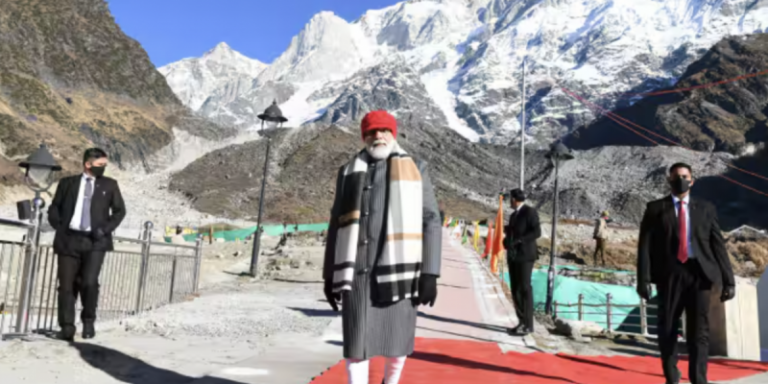The scorching heat, sandstorms, clogged roads, and rows of rafts on the Ganges. The crowded riverbank is a cheesy version of Mumbai’s Chowpatty. Plastic waste is everywhere, stinking garbage dumps everywhere. Plus prostitution, the Ankita Bhandari rape case, a billboard boasting the world’s highest bungee jump, and throngs of rowdy tourists with beer cans and selfies. The revered “Muni ki Leti” is a car park-cum-alcohol center with DJs blaring, and nearby are luxury spas, luxury hotels, and international ashrams with asana practitioners. This sweltering sandstorm is none other than Rishikesh, the city of yoga, and this is what “spiritual” tourism looks like.
Chardham Yatra was once a pilgrimage, then “spiritual” tourism and now just a stampede. In May this year, it attracted a staggering 1.4 million tourists in the first 20 days. The Uttarakhand government has set a daily limit of 18,000 tourists at Kedarnath, 11,000 at Gangotri, 20,000 at Badrinath and 9,000 at Yamunotri, an increase of about 50% compared to 2022. This means that each person has less than five seconds to actually experience darshan before the police whisk them away.
And to feed this frenzy, the gods are working overtime: afternoon meals and breaks are cut, online pujas continue through the night, and dawn breaks start a new day of relentless darshan. This irreverence holds a mirror up to how far our spirituality has fallen.
Are our gods living statues or stone? Does the Puran Pratishta Mantra invoke the divine presence in them or not? Is the laser show on the walls of Kedarnath temple an indication of devotion?
Also read: Uttarkashi tunnel collapse calls for immediate scientific review of Char Dham project
We were certainly lectured on that point during the elaborate installation of Ram Rala in Ayodhya. And the deities of Chardham are ancient. While this frenzy of tourists flocks, the lower classes, villagers and true devotees are barricaded in the fields, begging to be let through but are not allowed in as they do not live in a world of computer access and are unaware of online registration. There are also no footpaths for those who still believe that the pilgrimage should be made on foot as the Chardham Pariyojana (CDP) sacrificed it to widen roads to accommodate speeding vehicles.
Amid unprecedented heat, landslides, forest fires, water crisis and tourism-related construction boom in the Himalayas, especially in the forbidden floodplains, the Ministry of Road Transport and Highways is still pushing ahead with the construction of a 12-metre wide road. What is totally incomprehensible is that this width is specifically required for 10,000 Passenger Car Units (PCUs) per day, yet the government is forced to restrict tourist inflow much lower than this due to congestion in these narrow valleys. Even if we take a conservative average of five people per vehicle and ignore buses, the vehicles are much less than 5000 PCUs per day. Even with these restrictions, a 10-km long traffic jam has reoccurred, 30 km downstream of Kedarnath, starting from Gaurikund, the same stretch where lives were lost in the 2013 floods.
This is because the topography and limited carrying capacity of these valleys have been grossly neglected. In constructing this unnecessarily wide road, widespread slope failures and landslides have been caused. Recently, another Rs 14 billion from taxpayers’ money has been approved to CDP for management of the destabilised slopes. Experts who monitored the Sirkiyara tunnel, where 40 labourers were trapped alive, admit that the tunnel’s 12 metre width was a major contributing factor. We are funding our own destruction. And it is a vicious circle.
“Spiritual” tourism is a dangerous oxymoron. “Spiritual” tourists dump an estimated 10,000 kg of garbage per dam every day, “spiritual” tourists defecate on the roads and on the banks of the Ganges, “spiritual” tourists throw whiskey bottles and styrofoam plates from their cars as they move. They also consider it their right to blast music at full volume and take naked selfies with the mountains and shrines as a backdrop. And they race, honking their horns and kicking up dust storms, among the pines, oaks and startled mountain fauna. Is there anything spiritual about this desecration and selling off of the Himalayas?
Before the $5 trillion dizzying prospect, the approach was different. Mountain villagers never walked in shoes or shouted at Bugyal, home of the gods. People hesitated to spend the night at the dam, lest they defecate, desecrating the sacred site. Even wearing flashy clothes was considered disrespectful. And Rishikesh itself was once a haven for wandering monks like Swami Vivekananda, who enjoyed the crystal-clear waters of the Ganges, where fish fed from their hands and elephants came to drink.
And since this fiasco is being practiced as Sanatan Dharma, let us be clear. Sanatan Dharma looks at things and says, “How can I cultivate this?” Modern man of “New India” looks at things and says, “How can I consume this?” Modern India is digging a tunnel through the immortal Ganges, turning Char Dham into Char Dham, and trying to destroy the Himalayas. We have sold our eternal wisdom and have come to a state where we know nothing of the value of things, only the price of things.
Priyadarshini Patel is the managing director of Ganga Aavan, a citizens’ forum working to protect the Ganges and the Himalayas.
This article was first published in The India Cable, the premium newsletter from The Wire and Galileo Ideas, and has been updated and republished here. To subscribe to The India Cable, click here.

